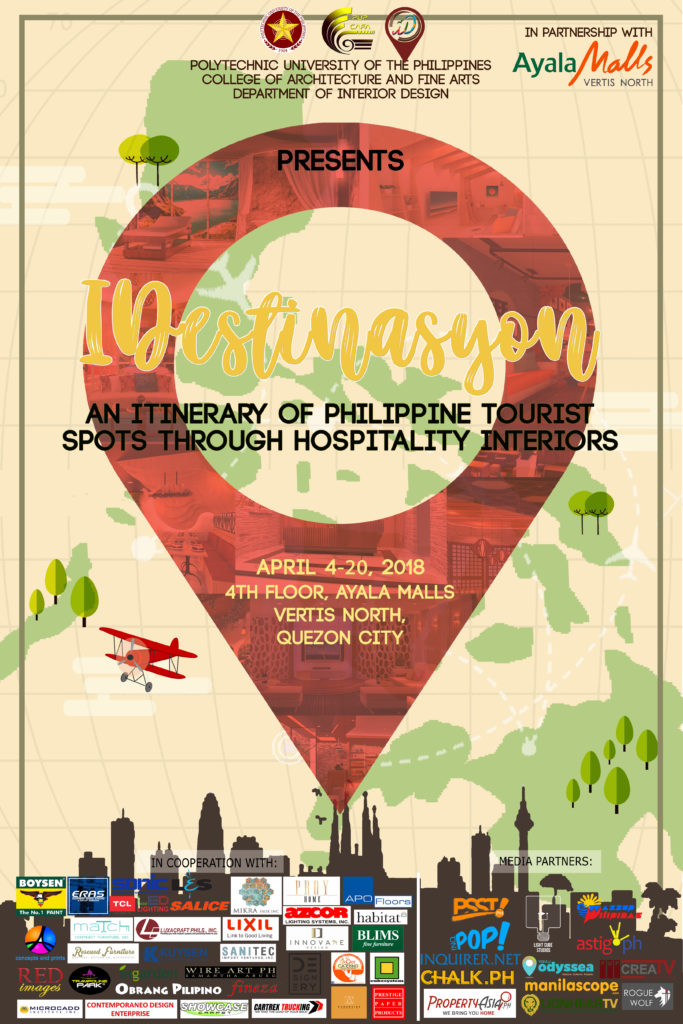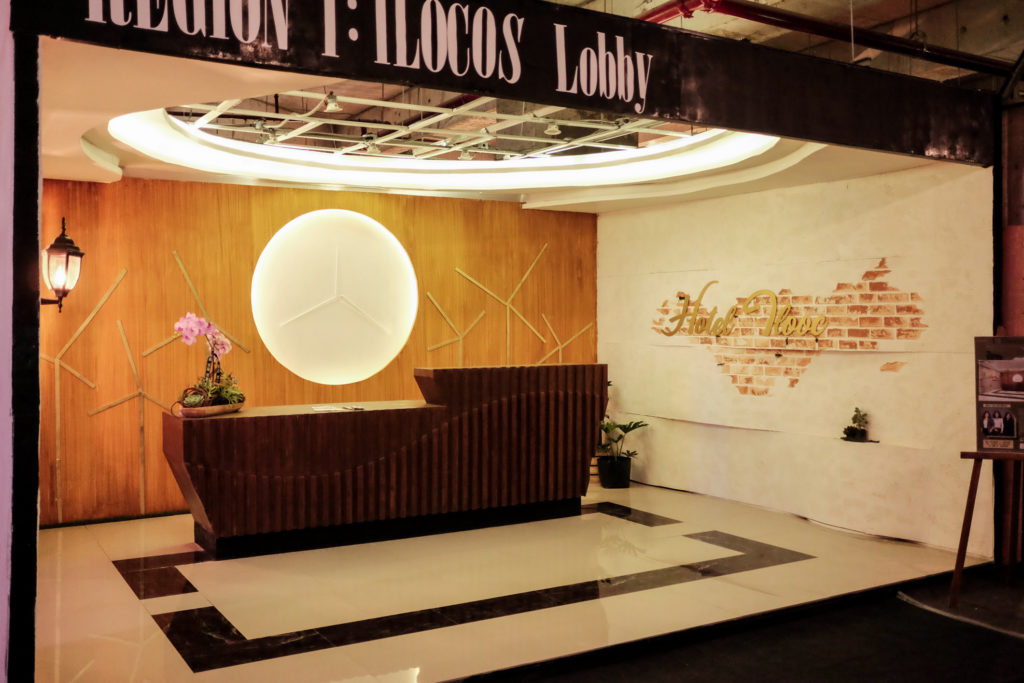Booth 1:Hotel Lobby | Timeless Ilocos
Ilocos region is undeniably one of the Philippines’ finest when it comes to stunning tourist destinations. The region is situated at the northwestern coast of Luzon.
Ilocos’ allure inspired the interior design of the hotel lobby showcasing its magnificent and ageless beauty. The Bangui Wind Farm featured on the ac�cent wall gives emphasis to the uniqueness of the place, in incorporation with Vigan’s well-known Calle Crisologo, and the enormous buttresses of old churches, while its pristine beaches noticeably influenced the ceiling design. The Kapurpurawan Rock Formation’s form and color inspired the reception desk and floor. Together with the other elements, the design proudly embodies the timeless beaut of Ilocos region, giving everyone a beauty to remember.
Booth 2: Karaoke Room | Basco Lighthouse
Basco Lighthouse is situated in the town of Basco in Batanes, the northernmost province in the Philippines. Standing at 66-feet, the lighthouse compris�es of six stories, with a viewing deck on the fifth, allowing unobstructed views of the West Philippine Sea to the west, Mt. Iraya to the north, and the Basco Town Proper to the south.
In this karaoke room, the design was derived from the physical structure of the lighthouse. Inspiration from the lantern room, stone masonry and shape of windows and door can be seen around the interior.
The interior comprises of light colors and balancing it with the lighting, will bring comfort whilst having enjoying yourselves immersed in singing.
Booth 3: Spa Room | Mount Pinatubo
Mt. Pinatubo is an active stratovolcano located on the tripoint boundary of the Philippine provinces of Zambales, Tarlac and Pampanga. The beautiful catastrophe of the mountain was one of the most known disasters that left a mark in the history of the Philippines. The 1991 eruption caused a big im�pact, destroying everything in its path which was also felt worldwide. Nevertheless, who would have thought that this beautiful landscape was ironical�ly created by destruction? It was simply beautiful.
Through the natural God-creation beauty of the Pinatubo, this spa design was made. Inspired by the eccentric formation of the mountain, down to the devastated field full of lahar, the gaze of the emerald waters of the Caldera lake, neighboring ethnic settlements and one of, if not the best, perfect spot to view the mountain’s beauty in destruction.
The natural subtle tones give calm to the interior and the warm-welcoming ambience that embraces relaxation rewards you with the same stunning captivity of the place which lets you forget all the weight of troubles and burdens in your life, perfect for those who seek peace and serenity.
Booth 4: Coffee Shop | Palawan
Taking inspiration from the magnificent Puerto Prinsesa Underground River, this coffee shop executed from “continuous drips of water”, forming a truly amazing work nature underneath. Designing a 20 million old splash entirely to the coffee shop, emulating the quick slipping, falling slowly like making a coffee.
Booth 5: Restaurant | Bicol
Booth V is a dining area of a fine-dining restaurant that serves Filipino cuisine. This booth showcases the best of Bicol region; from its branding/restaurant name: Kakang Gata – or coconut cream, richest and thickest consistency extracted on Niyog, to its concept: Mayon Volcano – world’s most perfect volcanic cone, to its main material: Manila Hemp – world famous product exported from Albay. The concept is applied in the space thru utilizing symmetry in plan, geometric shapes and taking its rocky and earthy tones.
Taste and see the best of Bicol region here at Kakang Gata Restaurant.”
Booth 6: Nail Salon | Boracay
CITY IN A PARADISE
Boracay Island belongs to the Western Visayas island-group, Region 6 of the Philippines, along with the western part of the province of Negros, island of Panay, and has a total land area of 10.32 square kilometers.
Harnessing an interior sense of beauty yet creating a functional detail that would definitely bring relaxation with rewarding services to experi�ence a short-time vacation, just within the metro. Pinoys are generally more of easy goer than other Asians, people are not stuck up and like to enjoy life, not too uptight about relaxing which directed the space design to be amenable for all to hang around.
The interior comprises of low-key colors, with the stability of furniture allocation in both sides of the space to express an undeniably easy atmosphere similar to the island.
Booth 7: Music Lounge | Haladaya Festival
In the province of Daanbantayan, The Haladaya Festival- one of the grandest and colorful festival in Cebu fills the street with smiles, endless music and dynamic dances celebrated every August 30. This festival commemorates the bravery of Datu Daya on protecting his territory called “Kandaya” from the Moro Pirates. Kandaya was later changed to Daanbantayan which means “lookout”.
The interior layout of the music lounge was designed to resemble how Datu Daya defended his territory, showcased through the idea of dividing the bar and lounge to portray different functions. Also, the lounge area gives off a good feeling of being protected. Bamboo, wood and other indigenous materials were featured because it was used by the traditional and indigenous dwellings during the reign of Datu Daya.
This music lounge wish to cater to different types of customers that will serve as a haven not only for happy hours, but will be a perfect outlet to re�lease stress as well.
Booth 8: Hotel Suite | Biri Rock Formation
Biri Rock Formation is sighted at the Biri Isand – northwest tip of Northern Samar. Strong winds, movement of tectonic plates, intense heat and whipping waves carved the rock formations – earning the description of the Battle of the Gods.
The hotel suite is designed based on the huge waves meeting the rocks. The accent wall that outstretched to the ceiling mimics the huge waves crashing onto the elevated area that portrays the rock formation.
The interior design evokes coziness and warmth through the color palette and textured finishes that render a homey, relaxing and comfortable feeling while staying at the hotel suite.
Booth 9: Bar | Vinta Regatta
Zam-bongga!
Vinta is a a native boat of Zamboanga, an island on Southern Philippines. It is famous for its dazzling colorful cloth sailing which embodies the rich and spectral culture highly influenced by Spaniards to the different tribes, religious views and daily lives of the people.
Regatta, on the other hand, is a popular event during Zamboanga Hermosa Festival(also called as Fiesta Pillar in honor of the city’s patroness, Our Lady of Pillar) that showcases the racing of vinta boats on the beat of the drums and ladies’ dancing via shore line.
Vinta Regatta is a powerful concept that illuminates the legacy-reached elements present on a vinta boat and letting it sail on the vast bodies of waters through the proposed interior design execution via the designer’s space, the Bar.
Booth 10: Bakeshop | Northern Mindanao
Barotorera is a traditional boat or yacht racing festival along the astonishing sea waters of Ginoog City in Misamis Oriental, one of the provinces in Northern Mindanao. A rowboat, Baroto, is made from dug-out canoes and installed with double outriggers with interesting colors and patterns on its sails.
As it is one of the region’s prides, molded by rich history, intricate artistry and everlasting durability, the designers adapted the edgy form of the Baroto itself into the boulangerie interiors which brought character to the space. The shop is designed to mimic the relaxing ambiance of the region’s natural scenery conveyed through a modern tropical interior that gives a connection to nature while enjoying the baked goods the shop has to offer.
Booth 11: Bedroom and Breakfast | Samal Island
Davao is known for its durian and it is the home of the Philippine Eagle. But within it is a remote island that is highly popular because of its pearl farming and its scenic sunset, the Samal Island. This tropical beach creates drama in the interior through the use of colors of the sea and sunset. The curves convey the waves of the sea that gives a relaxing feeling. The separation of the seashore and the ocean is seen thru the elevated flooring that celebrates beauty thru diversity, passage of time and mystery of life. Lastly, the tropical nature of the pearl farm is interpreted in the interior using natural materials such as pebbles, woods, Abaca, foliage and the mother of pearls or the Capiz shells, that will fulfill the warm accommodation that every guest wants to experience in their leisure time with their family.
Booth 12: Café | Lake Sebu
In the province of South Cotabato lies the waters of Lake Sebu. Aside from freshwater species, one of most notable tribes that also call it home is the T’boli tribe.
The fluid forms of the lake can be seen from the walls and ceiling, then to the furniture pieces and counter. The color of the banquette upholstery is based on the T’nalak fabric of the T’boli which is usually a deep red in color. Hints of greens depicting the lush forests around the lake can also be seen in the design through plant decors and a built-in artificial grass wall. For the signage, a wooden fish carcass is hung on the ceiling with the name of the establishment, “Lakeside Café”.
Booth 13: Kids’ Playroom | Enchanted River
From the town of Hinatuan in Surigao del Sur of Caraga Region lays a body of water with a unique feature of unfathomable depth and crystal-clear wa�ter and its mysterious and creepy stories of spirits that is believed to be the guardians where they coined the name “Enchanted River”. The enchanting history and undeniable beauty inspired the designers to create a playroom where it showcase a captivating and exciting space especially made for kids.
Adapting the colors of the scene and creating an adventurous activities was applied to the interior while interpreting the enchanting story through the child’s point of view.
Booth 14: Business Center | CAR
As a business center, the room inspired by the mystical town of Sagada in the Cordilleras portrays the main industries the Sagadans are endowed with. The geo form of the town is simulated through the elevated flooring. It also represents the primary livelihood of its people – rice terraces farming.
Walls adjacent to the accent are reminiscent of the Sumaguing cave’s majestc limestone filled interior. Cove lights portray the glimpse of sunrise inside a cave. The art of pottery is evident through the layout presented in a circular form with its spiral ceiling meeting the mouth of the pot, and the working stations are fabbergasted with colors through the harp shaped divider symbolizing the weaving craft. Covering each angles are reserved for the creation from God himself, a seemingly depiction of a 180 degree view of Kilteplan Peak to display His majestic work of art.



